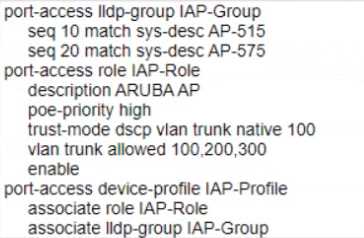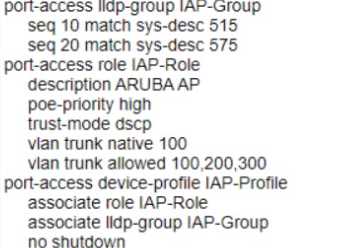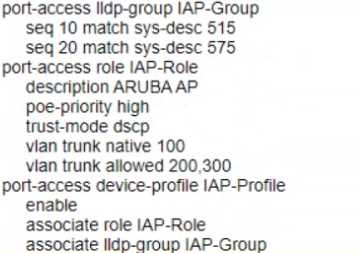HP hpe7-a01 practice test
HPE Network Campus Access Professional
Question 1
Which feature supported by SNMPv3 provides an advantage over SNMPv2c?
- A. Transport mapping
- B. Community strings
- C. GetBulk
- D. Encryption
Answer:
D
Explanation:
Encryption is a feature supported by SNMPv3 that provides an advantage over SNMPv2c. Encryption
protects the confidentiality and integrity of SNMP messages by encrypting them with a secret key.
SNMPv2c does not support encryption and relies on community strings for authentication and
authorization, which are transmitted in clear text and can be easily intercepted or spoofed. Transport
mapping, community strings, and GetBulk are features that are common to both SNMPv2c and
SNMPv3. Reference:
https://www.arubanetworks.com/techdocs/ArubaOS_86_Web_Help/Content/arubaos-
solutions/snmp/snmp.htm
https://www.arubanetworks.com/techdocs/ArubaOS_86_Web_Help/Content/arubaos-
solutions/snmp/snmpv3.htm
Question 2
You are doing tests in your lab and with the following equipment specifications
• AP1 has a radio that generates a 10 dBm signal
• AP2 has a radio that generates a 11 dBm signal
• AP1 has an antenna with a gain of 9 dBi
• AP2 has an antenna with a gain of 12 dBi.
• The antenna cable for AP1 has a 2 dB loss
• The antenna cable for AP2 has a 3 dB loss
What would be the calculated Equivalent Isotropic Radiated Power (EIRP) for APT?
- A. 26 dBm
- B. 30 dBm
- C. 17 dBm
- D. -12 dBm
Answer:
C
Explanation:
The calculated Equivalent Isotropic Radiated Power (EIRP) for AP1 is 17 dBm.
EIRP is the measured radiated power of an antenna in a specific direction. It is equal to the input
power to the antenna multiplied by the gain of the antenna. It can also take into account the losses
in transmission line, connectors, and other components. The formula for EIRP is:
EIRP = P + G - L
where P is the output power of the radio, G is the gain of the antenna, and L is the loss of the cable
and connectors.
For AP1, we have:
P = 10 dBm G = 9 dBi L = 2 dB
Therefore,
EIRP = 10 + 9 - 2 EIRP = 17 dBm
Question 3
With Aruba CX 6300. how do you configure ip address 10 10 10 1 for the interface in default state for
interface 1/1/1?
- A. int 1/1/1. switching, ip address 10 10 10 1/24
- B. int 1/1/1. no switching, ip address 10 10 10.1/24
- C. int 1/1/1. ip address 10.10.10.1/24
- D. int 1/1/1. routing, ip address 10.10.10 1/24
Answer:
B
Explanation:
To configure an IP address for an interface in default state for interface 1/1/1 on Aruba CX 6300
switch, you need to disable switching on the interface first with the command no switching. Then you
can assign an IP address with the command ip address. The other options are incorrect because they
either do not disable switching or use invalid keywords such as switching or routing. Reference:
https://www.arubanetworks.com/techdocs/AOS-CX_10_08/UG/bk01-ch01.html
https://www.arubanetworks.com/techdocs/AOS-CX_10_08/UG/bk01-ch02.html
Question 4
A system engineer needs to preconfigure several Aruba CX 6300 switches that will be sent to a
remote office An untrained local field technician will do the rollout of the switches and the mounting
of several AP-515s and AP-575S. Cables running to theAPs are not labeled.
The VLANs are already preconfigured to VLAN 100 (mgmt), VLAN 200 (clients), and VLAN 300 (guests)
What is the correct configuration to ensure that APs will work properly?
A)
B)
C)
D)
- A. Option A
- B. Option B
- C. Option C
- D. Option D
Answer:
C
Explanation:
Option C is the correct configuration to ensure that APs will work properly. It uses the ap command
to configure a port profile for APs with VLAN 100 as the native VLAN and VLAN 200 and 300 as tagged
VLANs. It also enables LLDP on the ports to discover the APs and assign them to the port profile
automatically. The other options are incorrect because they either do not use the ap command, do
not enable LLDP, or do not configure the VLANs correctly. Reference:
https://www.arubanetworks.com/techdocs/AOS-CX_10_08/UG/bk01-ch02.html
https://www.arubanetworks.com/techdocs/AOS-CX_10_08/UG/bk01-ch03.html
Question 5
Your Director of Security asks you to assign AOS-CX switch management roles to new employees
based on their specific job requirements After the configuration was complete, it was noted that a
user assigned with the administrators role did not have the appropriate level of access on the switch.
The user was not limited to viewing nonsensitive configuration information and a level of 1 was not
assigned to their role Which default management role should have been assigned for the user?
- A. sysadmin
- B. operators
- C. helpdesk
- D. config
Answer:
B
Explanation:
The default management role that should have been assigned for the user is B. operators.
The operators user role is a predefined role that allows users to view nonsensitive configuration
information on the switch, such as interfaces, VLANs, routing protocols, statistics, and more.
The
operators user role has a privilege level of 1, which is the lowest level of access on the switch1
.
The administrators user role is a predefined role that has full access to all switch configuration
information and all REST API methods.
This role is more than what the Director of Security requires1
.
Question 6
A new network design is being considered to minimize client latency in a high-density environment.
The design needs to do this by eliminating contention overhead by dedicating subcarriers to clients.
Which technology is the best match for this use case?
- A. OFDMA
- B. MU-MIMO
- C. QWMM
- D. Channel Bonding
Answer:
A
Explanation:
OFDMA (Orthogonal Frequency Division Multiple Access) is a technology that can minimize client
latency in a high-density environment by eliminating contention overhead by dedicating subcarriers
to clients. OFDMA allows multiple clients to transmit simultaneously on different subcarriers within
the same channel, reducing contention and increasing efficiency. MU-MIMO (Multi-User Multiple
Input Multiple Output) is a technology that allows multiple clients to transmit simultaneously on
different spatial streams within the same channel, but it does not eliminate contention overhead.
QWMM (Quality of Service Wireless Multimedia) is a technology that prioritizes traffic based on four
access categories, but it does not eliminate contention overhead. Channel Bonding is a technology
that combines two adjacent channels into one wider channel, increasing bandwidth but not
eliminating contention overhead. Reference:
https://www.arubanetworks.com/assets/ds/DS_AP510Series.pdf
https://www.arubanetworks.com/assets/wp/WP_WiFi6.pdf
Question 7
Your manufacturing client is having installers deploy seventy headless scanners and fifty IP cameras
in their warehouse These new devices do not support 802 1X authentication.
How can HPE Aruba reduce the IT administration overhead associated with this deployment while
maintaining a secure environment using MPSK?
- A. Have the installers generate keys with ClearPass Self Service Registration.
- B. Have the MPSK gateway derive the unique pre-shared keys based on the MAC OUI.
- C. Use MPSK Local to automatically provide unique pre-shared keys for devices.
- D. MPSK Local will allow the cameras to share a key and the scanners to share a different key
Answer:
C
Explanation:
MPSK Local is a feature that can reduce the IT administration overhead associated with deploying
devices that do not support 802.1X authentication while maintaining a secure environment. MPSK
Local allows the switch to automatically generate and assign unique pre-shared keys for devices
based on their MAC addresses, without requiring any configuration on the devices or an external
authentication server. The other options are incorrect because they either require manual
intervention by the installers or the MPSK gateway, or they do not provide unique pre-shared keys
for devices. Reference: https://www.arubanetworks.com/techdocs/AOS-CX_10_08/UG/bk01-ch05.html
https://www.arubanetworks.com/techdocs/AOS-CX_10_08/UG/bk01-ch06.html
Question 8
Which component is used by the Aruba Network Analytics Engine (NAE)?
- A. JSON-based scripts
- B. Lisp-based agents
- C. Ruby-based scripts
- D. Current State Database
Answer:
A
Explanation:
The component that is used by the Aruba Network Analytics Engine (NAE) is D. Current State
Database.
The Current State Database is a database that stores the configuration and state information of the
switch, such as interfaces, VLANs, routing protocols, statistics, and more. The NAE can access this
database through the AOS-CX REST API and monitor the values of any data point using monitors.
The
NAE can also track the history of the values in a time-series database and correlate them with
network events or configuration changes1
.
The Current State Database provides NAE with direct
visibility into the entire current state of the device, which enables intelligent troubleshooting and
automation of network tasks1
.
The other options are incorrect because:
A) JSON-based scripts: JSON is a data format that is used to exchange information between
applications. It is not a scripting language that can be used by NAE.
NAE scripts are written in Python,
which is a popular and powerful programming language1
.
B) Lisp-based agents: Lisp is a family of programming languages that are mainly used for artificial
intelligence and functional programming. It is not a language that can be used by NAE.
NAE agents
are instances of scripts that run on the switch and collect relevant network information and trigger
alerts or actions1
.
C) Ruby-based scripts: Ruby is a general-purpose programming language that is known for its
expressiveness and elegance. It is not a language that can be used by NAE.
NAE scripts are written in
Python, which is a popular and powerful programming language1
.
Question 9
You need to have different routing-table requirements with Aruba CX 6300 VSF configuration
Assuming the correct layer-2 VLAN already exists how would you create a new OSPF configuration for
a separate routing table?
- A. Create a new OSPF area, and attach VRF name.
- B. Create a new OSPF process ID with vrf name.
- C. Attach a new OSFP process ID with a custom routing table
- D. Attach OSPF process ID in the VRF configuration.
Answer:
B
Explanation:
To create a new OSPF configuration for a separate routing table, you need to create a new OSPF
process ID with vrf name. This will create a new OSPF instance that is associated with the specified
VRF and its routing table. The other options are incorrect because they either do not create a new
OSPF instance or do not associate it with a VRF. Reference:
https://www.arubanetworks.com/techdocs/AOS-CX/10.04/HTML/5200-6728/bk01-ch02.html
https://www.arubanetworks.com/techdocs/AOS-CX/10.04/HTML/5200-6728/bk01-ch03.html
Question 10
With the Aruba CX switch configuration, what is the first-hop protocol feature that is used for VSX L3
gateway as per Aruba recommendation?
- A. Active Gateway
- B. Active-Active VRRP
- C. SVI with vsx-sync
- D. VRRP
Answer:
A
Explanation:
Active Gateway is the first-hop protocol feature that is used for VSX L3 gateway as per Aruba
recommendation. Active Gateway is a feature that allows both VSX peers to act as active gateways
for different subnets, eliminating the need for VRRP or other first-hop redundancy protocols. Active
Gateway also provides fast failover and load balancing for L3 traffic across the VSX peers. The other
options are incorrect because they are either not recommended or not supported by Aruba CX VSX.
Reference: https://www.arubanetworks.com/techdocs/AOS-CX/10.04/HTML/5200-6728/bk01-ch07.html
https://www.arubanetworks.com/resource/aruba-virtual-switching-extension-vsx/
Question 11
You are deploying a bonded 40 MHz wide channel What is the difference in the noise floor perceived
by a client using this bonded channel as compared to an unbonded 20MHz wide channel?
- A. 2dB
- B. 3dB
- C. 8dB
- D. 4dB
Answer:
B
Explanation:
The difference in the noise floor perceived by a client using a bonded 40 MHz wide channel as
compared to an unbonded 20 MHz wide channel is 3 dB. The noise floor is the level of background
noise in a given frequency band. When two adjacent channels are bonded, the noise floor increases
by 3 dB because the bandwidth is doubled and more noise is captured. The other options are
incorrect because they do not reflect the correct relationship between bandwidth and noise floor.
Reference: https://www.arubanetworks.com/techdocs/ArubaOS_86_Web_Help/Content/arubaos-
solutions/wlan-rf/rf-fundamentals.htm
https://www.arubanetworks.com/techdocs/ArubaOS_86_Web_Help/Content/arubaos-
solutions/wlan-rf/channel-bonding.htm
Question 12
When setting up an Aruba CX VSX pair, which information does the Inter-Switch Link Protocol
configuration use in the configuration created?
- A. QSVI
- B. MAC tables
- C. UDLD
- D. RPVST+
Answer:
B
Explanation:
The information that the Inter-Switch Link Protocol configuration uses in the configuration created is
B. MAC tables.
The Inter-Switch Link Protocol (ISL) is a protocol that enables the synchronization of data and state
information between two VSX peer switches. The ISL uses a version control mechanism and provides
backward compatibility regarding VSX synchronization capabilities.
The ISL can span long distances
(transceiver dependent) and supports different speeds, such as 10G, 25G, 40G, or 100G1
.
One of the data components that the ISL synchronizes is the MAC table, which is a database that
stores the MAC addresses of the devices connected to the switch and the corresponding ports or
VLANs.
The ISL ensures that both VSX peers have the same MAC table entries and can forward traffic
to the correct destination2
.
The ISL also synchronizes other data components, such as ARP table,
LACP states for VSX LAGs, and MSTP states2
.
Question 13
What is true regarding 802.11k?
- A. It extends radio measurements to define mechanisms for wireless network management of stations
- B. It reduces roaming delay by pre-authenticating clients with multiple target APs before a client roams to an AP
- C. It provides mechanisms for APs and clients to dynamically measure the available radio resources.
- D. It considers several metrics before it determines if a client should be steered to the 5GHz band, including client RSSI
Answer:
C
Explanation:
802.11k is a standard that provides mechanisms for APs and clients to dynamically measure the
available radio resources in a wireless network. 802.11k defines radio resource management (RRM)
functions, such as neighbor reports, link measurement, beacon reports, etc., that allow APs and
clients to exchange information about the RF environment and make better roaming decisions. The
other options are incorrect because they describe other standards, such as 802.11r, 802.11v, or
802.11ax. Reference: https://www.arubanetworks.com/assets/wp/WP_WiFi6.pdf
https://www.arubanetworks.com/assets/ds/DS_AP510Series.pdf
Question 14
Your customer is interested in hearing more about how roles can help keep consistent policy
enforcement in a distributed overlay fabric How would you explain this concept to them''
- A. Group Based Policy ID is applied on egress VTEP after device authentication and policy is enforced on ingress VTEP
- B. Role-based policies are tied to IP addresses which have an advantage over IP-based policies and role names are sent between VTEPs
- C. Group Based Policy ID is applied on ingress VTEP after device authentication and policy is enforced on egress VTEP
- D. Role-based policies enhance User Based Tunneling across the campus network and the policy traffic is protected with iPsec
Answer:
C
Explanation:
This is the correct explanation of how roles can help keep consistent policy enforcement in a
distributed overlay fabric. Roles are used to assign group based policy IDs (GBPs) to devices after
they authenticate with ClearPass or a local database. GBPs are then used to tag the traffic from the
devices and send them to the ingress VTEP, which applies the GBP on the VXLAN header. The egress
VTEP then enforces the policy based on the GBP and the destination device. The other options are
incorrect because they either do not describe the correct sequence of events or do not use the
correct terms. Reference: https://www.arubanetworks.com/techdocs/AOS-CX/10.04/HTML/5200-6728/bk01-ch03.html
https://www.arubanetworks.com/techdocs/AOS-CX/10.04/HTML/5200-6728/bk01-ch05.html
Question 15
How is Multicast Transmission Optimization implemented in an HPE Aruba wireless network?
- A. "The optimal rate for sending multicast frames is based on the highest broadcast rate across all associated clients
- B. When this option is enabled the minimum default rate for multicast traffic is set to 12 Mbps for 5 GHz
- C. The optimal rate for sending multicast frames is based on the lowest broadcast rate across all associated clients.
- D. The optimal rate for sending multicast frames is based on the lowest unicast rate across all associated clients.
Answer:
D
Explanation:
multicast transmission optimization is a feature that allows the IAP to select the optimal rate for
sending broadcast and multicast frames based on the lowest of unicast rates across all associated
clients1
. When this option is enabled, multicast traffic can be sent at up to 24 Mbps. The default rate
for sending frames for 2.4 GHz is 1 Mbps and 5.0 GHz is 6 Mbps.
This option is disabled by default1
.